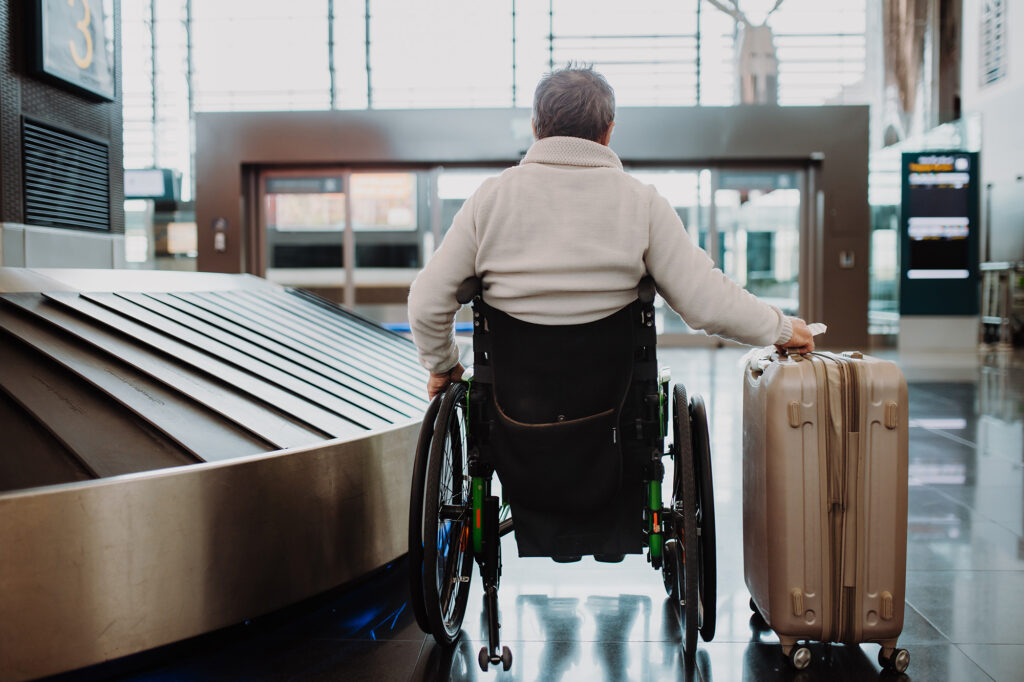Essential Travel Tips for Wheelchair Users: Booking Flights & Airport Navigation
Traveling by air with a wheelchair involves careful planning and communication to ensure a smooth and comfortable experience. Here is a detailed guide on what to consider when booking a flight and on the day of travel:

Booking the Flight When Traveling with a Wheelchair
1. Notify the Airline Early: Inform the airline about your wheelchair needs as soon as possible—ideally, when you book your ticket. This is crucial for arranging necessary assistance, including airport wheelchairs, help with boarding and deplaning, and storage of your wheelchair if needed. Airlines typically request at least 48 hours’ notice for special assistance, so it’s best to notify them well in advance.
Click below for the contact information to the top twenty airlines in the US:
2. Confirm Services and Accommodations: Different airlines offer varying levels of assistance and services for passengers with disabilities. Confirm the details of what services are provided, such as:
- Availability of aisle chairs (for boarding and deplaning).
- Assistance with carrying luggage.
- Accessible seating options (such as seats with extra legroom or proximity to the aisle).
- Policies for handling and storing electric wheelchairs or scooters. Ensure that the airline can accommodate your specific mobility aid and ask about any additional charges or requirements.
3. Request Special Assistance: If you have any additional needs, such as a special meal, additional time for boarding, or assistance with transfers, request these services during booking. Confirm these requests a few days before your flight to ensure that they have been properly recorded.
4. Understand the Airline’s Policies: Review the airline’s policies on traveling with mobility aids. This includes how they handle wheelchairs, any potential damage or loss procedures, and their policies for traveling with medical equipment. Understanding these policies can help you prepare for any potential issues and ensure your equipment is handled correctly.
5. Travel Insurance: Consider purchasing travel insurance that covers mobility aids. This can provide additional protection in case of damage or loss of your wheelchair or other equipment during your journey.
Airport & Check-in & Screening Issues for Wheelchair Users
Arrive at the airport well in advance of your flight to allow ample time for check-in, security screening, and addressing any issues that may arise. For domestic flights, aim to arrive at least two hours before departure; for international flights, consider arriving three hours early.
Go to the airline’s check-in counter or special assistance desk to confirm your assistance request and provide any necessary documentation. Depending on the airport, there may be designated desks for passengers requiring additional assistance. Make sure to check in early, as this can help smooth the process and avoid last-minute issues.
Expect additional screening at security. Security personnel may need to use a special chair for screening or conduct manual checks of your wheelchair. Inform the security staff of your needs, and they should provide appropriate assistance. If you use an electric wheelchair or scooter, be prepared to remove any batteries or components as per security regulations.
Follow the airline’s instructions for boarding. You may be allowed to pre-board or board with the assistance of airline staff. Boarding often occurs in a specific order, and those needing assistance are usually boarded first. Make sure to communicate with the flight attendants and let them know if you need any help during this process.
Inform the flight attendants of any special needs or preferences you have, such as assistance with moving to and from the restroom or securing your wheelchair. Flight attendants are trained to assist with a variety of needs and can help make your flight more comfortable.
Similar to boarding, deplaning should be handled with the assistance of airline staff if you need it. They can help with transferring from your wheelchair to an aisle chair and assist you as you leave the aircraft. Communicate with the crew in advance about your deplaning needs to ensure a smooth process.
Be prepared for potential delays or cancellations. If you encounter any issues with your wheelchair or other mobility aids, contact the airline’s customer service immediately. Having a plan for how to communicate your needs and manage unexpected changes can help reduce stress during travel.
Upon arrival, check that your wheelchair and any other equipment have arrived in good condition. If there are any issues, report them to the airline’s baggage service office or customer service desk. Many airlines provide compensation or repair services for damaged equipment.
Airports can be large and complex. Familiarize yourself with the layout of the airport, including accessible routes, restroom locations, and any available services for travelers with disabilities. Some airports offer maps or guides to help navigate, and airport staff can also provide assistance.
Effective communication with airline and airport staff is crucial. Clearly state your needs and any specific requirements you have throughout your journey. Being proactive and clear can help ensure that all necessary accommodations are provided.
By following these guidelines, you can help ensure that your air travel experience is as smooth and comfortable as possible. Proper planning and communication are key to a successful journey, allowing you to focus on enjoying your trip rather than managing travel-related stress.
Let Us Help you
Call us 24/7 if you would like to discuss your potential case further. All cases are handled on a contingency fee basis. That means we will never charge you any attorney’s fees or expenses unless we win your case.